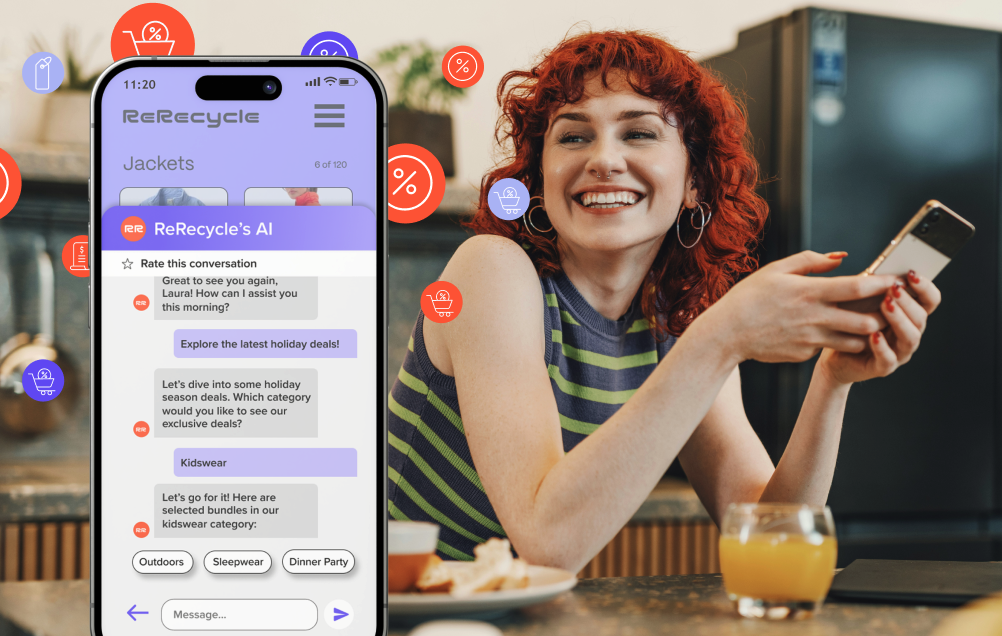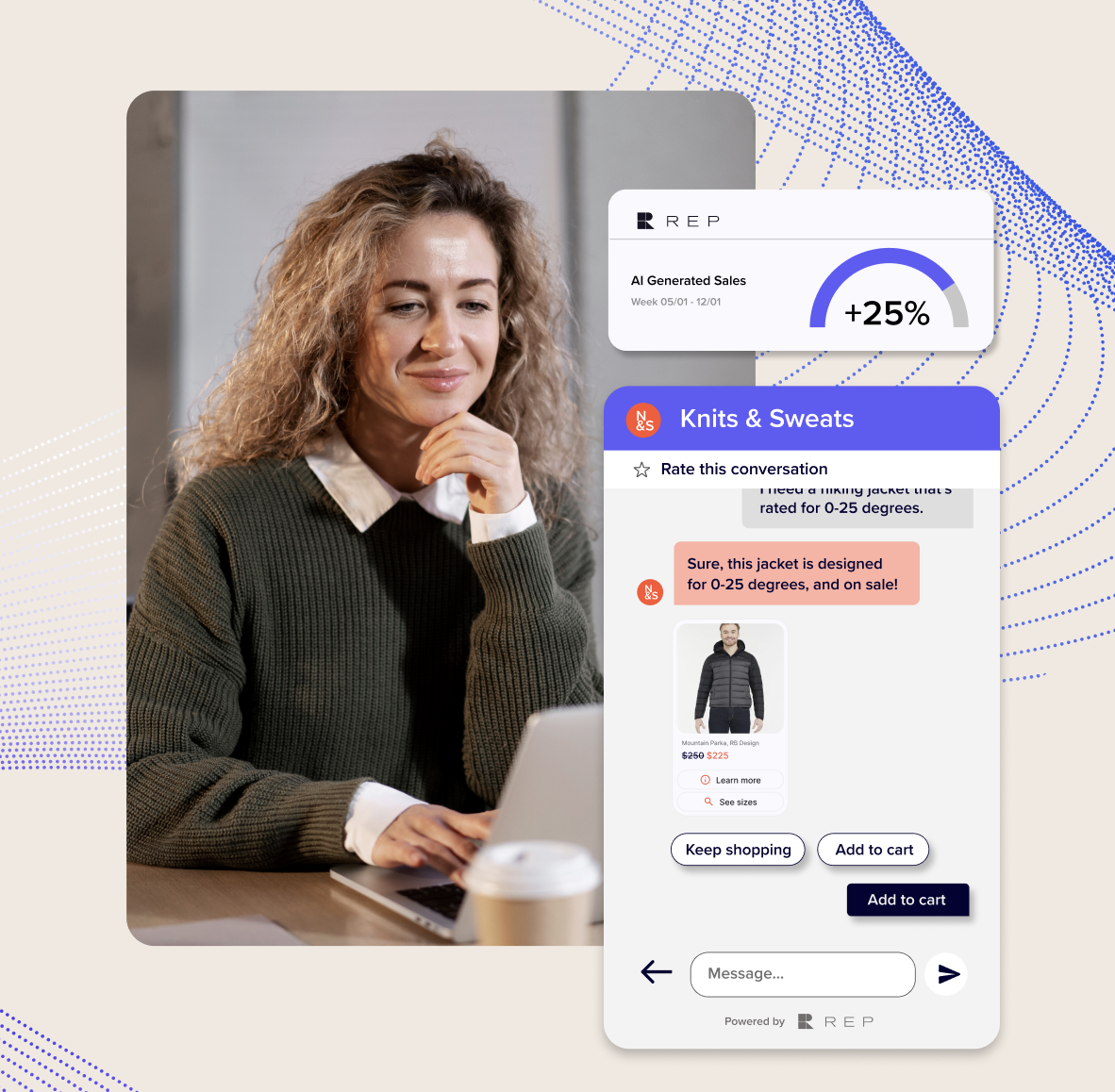Personalizing Product Recommendations With Conversational AI: Complete Implementation Guide
Online stores today use technology to make shopping more personal. Many shoppers see product recommendations based on what they have browsed or bought before. These suggestions are not random—they come from data about each shopper's interests and habits.
Conversational AI, powered by large language models (LLMs), can chat naturally with customers and learn from every interaction.
When used for product recommendations, it helps online stores offer suggestions that fit each person's unique style, needs, or previous purchases.
This guide explains how personalizing product recommendations with conversational AI works. It covers the basics, practical steps, and the business impact for eCommerce merchants.
Key Takeaways
- Conversational AI personalizes shopping by analyzing customer intent and context in real time.
- Personalization boosts conversion rates, increases average order value (AOV), and strengthens customer lifetime value (CLV).
- Success depends on clear KPIs, high-quality data, and continuous optimization through analytics and automated feedback loops.
- Effective conversation design improves customer satisfaction by showing fewer but more relevant recommendations.
- Limiting suggestions, blending support with sales, and keeping a consistent brand voice prevent fatigue and build trust.
- Implemented well, conversational AI reduces decision friction, deepens loyalty, and drives long-term eCommerce growth.
Why Personalized Recommendations Drive eCommerce Growth
Personalized recommendations are product suggestions created by artificial intelligence based on each customer's unique browsing history, shopping activity, and preferences. For eCommerce merchants, this means showing every visitor products that match their interests, rather than offering the same list to everyone.
When customers see relevant product suggestions, they face fewer choices and can decide what to buy more easily. This approach leads to three main business benefits:
- Higher conversion rates: Relevant suggestions reduce decision fatigue and guide customers toward purchase
- Larger average order values (AOV): Cross-selling and upselling through intelligent bundling increases transaction size
- Stronger customer loyalty: Personalized experiences create repeat customers who return for future purchases and increase long-term customer lifetime value (CLV).
Conversational AI takes this personalization further by engaging customers during key moments in their shopping journey, offering suggestions that match their current needs and past behavior.
How Conversational AI Generates Real Time Suggestions
Conversational AI today combines large language models (LLMs) with recommendation systems to deliver real-time, context-aware product suggestions during customer conversations. These systems use advanced natural language understanding to interpret intent, tone, and context—going far beyond traditional NLP—to generate responses that feel human and highly personalized.
Modern AI assistants don’t just recognize what customers say; they understand why they’re saying it. Through generative reasoning, they can capture meaning, context, and preferences all at once. If someone asks, “Show me running shoes under $100,” the AI instantly grasps the intent—affordable athletic footwear—and tailors its recommendations accordingly.
Today’s AI shopping assistants are also much better at remembering past conversations. Instead of treating every chat like a new one, they can recall what you’ve said before using AI-powered memory. So if you first ask about red jackets and later say “show me something waterproof,” the AI connects both requests and shows you red, waterproof jackets. That kind of continuity makes the experience smoother, faster, and far more personal.
Behind the scenes, recommendation engines are constantly learning. They analyze browsing behavior, chat interactions, and purchase history to rank products dynamically. As conversations continue, these rankings update in real time—surfacing what’s most relevant right now, not just what you liked before.
Step By Step Implementation Workflow
Setting up conversational AI for product recommendations follows a structured process that builds from business goals to live optimization.
Step 1: Define Business Goals and KPIs
Start by setting clear objectives and metrics to track success. Common key performance indicators include:
- Conversion rate (percentage of visitors who complete purchases)
- Average order value AOV (average amount spent per transaction)
- Recommendation click-through rate (percentage of customers who click suggested products)
- Customer satisfaction scores from post-chat surveys
Step 2: Audit and Prepare Data Sources
Review what customer information you currently collect and assess its quality. This includes website analytics, purchase history, product interactions, and any existing chat logs. Clean data produces more accurate recommendations.
Step 3: Choose Your Platform
Choose a conversational AI solution that supports LLM-based understanding, integrates seamlessly with your eCommerce platform, and allows fine-tuning for your brand voice and customer behavior patterns. REP AI offers one-click Shopify integration for streamlined installation.
Step 4: Map Conversation Flows
Design how conversations will progress and where recommendations will appear. Create dialogue scenarios for different customer journey stages, from homepage visits to checkout completion. Develop conversation starters like "Looking for something specific today?" or "Would you like suggestions based on your last order?"
Step 5: Integrate and Test
Connect your product catalog and customer data through provided APIs. Run test scenarios to confirm recommendations display correctly and conversations hand off to human agents when needed.
Step 6: Launch and Optimize
After launch, monitor performance and user feedback continuously. Many LLM-powered systems now self-optimize using feedback loops and conversational analytics. To maintain brand safety and consistency, these systems also include guardrails and content filters that ensure AI recommendations align with brand tone and compliance standards.
Best Practices for Conversation Design That Converts
Effective conversational design now includes prompt orchestration and persona tuning—balancing helpful service with authentic, human-like dialogue that naturally guides customers toward relevant products.
Ask clarifying questions early to understand what shoppers want. Questions like "Are you shopping for yourself or someone else?" or "What style interests you today?" help narrow down choices before showing recommendations.
Present limited but relevant options to avoid overwhelming customers. Show two to four carefully selected products that match stated preferences rather than long lists of possibilities.
Blend support and sales naturally by answering questions while identifying opportunities. If someone asks about return policies, provide the information and follow up with accessories that complement their recent purchases.
Use prompt libraries or orchestration tools to manage tone, product context, and conversation consistency at scale.The conversational tone and vocabulary should match your other customer communications, whether friendly and casual or professional and formal.
Cross Sell and Up Sell Tactics Inside Chat
Conversational AI increases order values by suggesting additional products during chat sessions based on real-time customer behavior and purchase history.
Complementary bundles work by analyzing cart contents and suggesting frequently paired items. When someone adds running shoes, the AI might recommend athletic socks, water bottles, or fitness trackers that other customers often buy together.
Post-purchase replenishment prompts remind customers to reorder consumable items based on typical usage cycles. Skincare products might trigger reminders after 30 days, while printer ink prompts could appear after three months.
Loyalty-based recommendations tailor suggestions to different customer segments. High-value customers see premium products and exclusive items, while new customers receive entry-level accessories and basic bundles.

Common Pitfalls and How To Avoid Them
Modern LLM-powered systems mitigate cold-start issues by using semantic understanding and reasoning. Even without past data, they can infer preferences from minimal input, such as a short message or browsing intent. You can further address this by asking direct preference questions in chat, using popular products as initial recommendations, and applying contextual cues like referral source to infer likely interests.
Recommendation fatigue occurs when customers see too many or irrelevant suggestions. Limit recommendations to two to four items per interaction, space suggestions throughout the customer journey, and pause them if customers ignore multiple prompts in a row.
Maintain transparent data practices and ensure compliance with regulations like GDPR. Many conversational AI platforms now use privacy-safe architectures—such as on-device inference or anonymized LLMs—to ensure no personal data is retained during interactions.
Key Metrics and Optimization Loops
Successful conversational AI systems rely on continuous measurement and improvement through specific performance indicators.
Track conversion rate and average order value (AOV) in real time using conversational analytics dashboards to measure revenue impact.
Compare these metrics before and after AI implementation, and monitor trends over consistent time periods.
Monitor response accuracy and containment rate to assess customer satisfaction. Response accuracy measures how often the AI provides correct answers, while containment rate shows the percentage of inquiries resolved without human intervention.
Use A/B testing to optimize conversation flows and recommendation strategies. Test different scripts, product suggestion algorithms, and timing approaches while measuring conversion rates, click-through rates, and customer satisfaction scores.
Turn Every Conversation Into Revenue With REP AI
REP AI transforms customer conversations into sales opportunities using generative AI and large language models (LLMs). The platform delivers natural, personalized interactions that adapt to each customer in real time—driving conversions and deepening brand loyalty.
The platform integrates directly with Shopify stores, syncing inventory and collections in real time while maintaining consistent brand voice across all interactions.
The system operates 24/7, handling common questions, guiding product discovery, and identifying cross-selling opportunities. Merchants can track analytics, monitor key metrics, and optimize recommendation strategies based on actual conversation data.
For eCommerce businesses ready to personalize their customer experience through conversational AI, REP AI offers a 30-day free trial.
FAQs
How much website traffic does a store need before conversational AI recommendations become effective?
Conversational AI works for stores with any traffic level because it learns from each customer interaction rather than requiring large amounts of historical data to begin making useful recommendations.
Can conversational AI transfer complex product questions to human agents while preserving conversation context?
Modern conversational AI platforms maintain complete conversation history and customer preferences when escalating to human support teams, ensuring no information gets lost during handoffs.
Do multilingual conversational AI chatbots maintain recommendation accuracy across different languages?
Quality multilingual AI systems understand customer intent rather than just translating words, which preserves recommendation relevance and accuracy regardless of the language used.
How quickly can eCommerce merchants expect return on investment after implementing conversational AI recommendations?
Most merchants see initial conversion improvements within the first month, with full return on investment typically achieved within three to six months of implementation.

.png)
.png)










